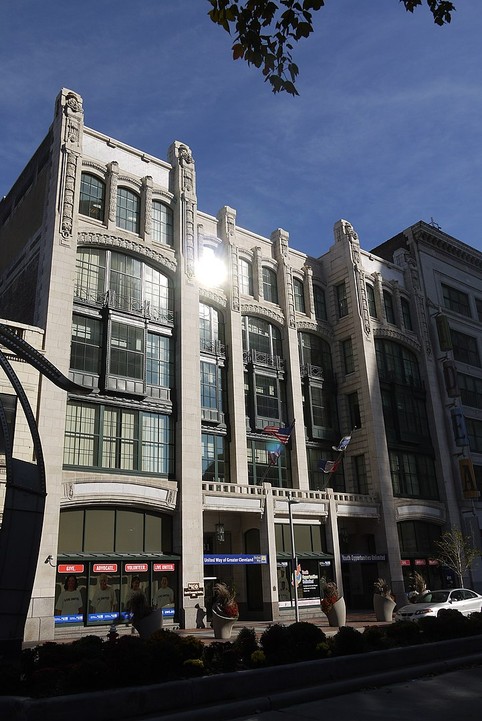Lindner Building
Introduction
Text-to-speech Audio
Images
2010 photo of the historic Lindner Building

Backstory and Context
Text-to-speech Audio
The Lindner Building is one of the remaining works of progressive architect Robert Kohn and serves as a reminder of an era when Cleveland's upper Euclid Avenue was home to one of the country's largest concentrations of clothing retailers. The Lindner Company served as the building's first tenant, having opened in 1915. After merging with other retailers, the store became known as Sterling-Lindner-Davis and moved down the street to a new location.
Max J. Lindner came to Cleveland in 1907, and one year later, in 1908, he opened a women's apparel shop along with two other well-known retailers, Max Hellman and Morris A. Black. The store enjoyed immediate success, earning a reputation as a store offering top-quality products imported from Paris. Additionally, the group routinely held charity events that proved popular within the community. They also hosted promotional events, including its annual "Celebrate Style Week," which drew thousands of people to downtown Cleveland.
Increasing sales convinced officials, in 1915, to vacate their first, small East 9th Street store for a new, far more spacious quarters at 1331 Euclid Avenue. The building design was conducted by Robert D. Kohn, a New York City architect who gained fame for his design of the New York Evening Post Building (1906). He maintained a dedication to the Art Nouveau style long after the type fell out of favor in Europe. He was also active in the Progressive Reform movements, summoning architects to design healthier working environments and public housing. Kohn's numerous articles note his conviction for social improvement through mindful architecture, which resulted in functional and efficient designs with innovative aesthetics.
However, around the time the Lindner store moved into the new building, the store's namesake, Max Lindner, left to manage a men's clothing firm. Consequently, Max Hellman, the company's secretary, took over as president of the Lindner store. He oversaw the store's growth after World War I, including adding a fashion-setting millinery shop and a popular tea room where guests could order high-end but affordable lunches. He remained the store's president until he died in 1923 at the young age of 47. After Hellman passed away, the final of the three partners, Morris A. Black, became president. Black, a Harvard graduate, ran the company for thirteen years. Black convinced the board to open branches in Ohio, Pennsylvania, and New York by the late 1920s.
When the Great Depression arrived in 1930, the store introduced an installment buying option -- sans interest -- to customers possessing healthy credit, an exceptionally successful strategy. Under Black's direction, the store also survived the Great Depression by continuing to host promotional events, hiring "special shoppers" who helped men shop for women, adding services such as a reasonably-priced French restaurant and beauty salon, and selling a few men's items. Black, the last of the store's founders, left the company shortly before his death in 1938.
The 1940s served as a more difficult decade for Lindner. Though the company profited during the war and, in turn, contributed to the war effort, the post-war era quickly ushered in a quick decline for Lindner. By 1947, the board voted to sell the company to the national Allied Stores chain. Allied administered a series of mergers that ultimately resulted in the formation of the Sterling-Lindner-Davis department store. The newly merged operation moved down the street, ending the store's history at its 1915 location.
New York's Bonwit Teller Company purchased the Lindner Building in the early 1950s. After they departed during the early 1970s, the discount store, Gen Mart, moved into the vacated space for a few years. It mostly remained abandoned until United Way Services moved into the building in 1995. As of 2020, amid the global COVID19 pandemic, the United Way remains in the building but announced changes to its operations.
Sources
Fisher, Tom "Nomination Form: The Lindner Building." archives.gov. September 13, 1978. https://catalog.archives.gov/id/71987532.
Klein, Richard, ""Let's Go Shopping at the Square" Cleveland's Leading Downtown Department Stores: A Business Legacy" (2014). Cleveland Memory. Book 25. http://engagedscholarship.csuohio.edu/clevmembks/25.
Owen, Lorrie K, ed. Dictionary of Ohio Places. Volume 2. St. Claire Shores, Michigan: Sommerset Publishers, 1999.
By Eli Pousson - originally posted to Flickr as Commercial Building, Euclid Avenue, Downtown Cleveland, CC BY-SA 2.0, https://commons.wikimedia.org/w/index.php?curid=11786288
